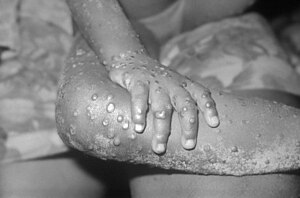| Mpox |
|---|
 |
| Mpox rash on arm and leg of a four-year-old girl in 1971 |
| Pronunciation | |
|---|
| Medical specialty | Infectious disease[1] |
|---|
| Symptoms | Rash, fever, exhaustion, swollen lymph nodes, muscle aches, sore throat[2] |
|---|
| Complications | secondary infections, pneumonia, sepsis, encephalitis, and loss of vision with severe eye infection[1] |
|---|
| Usual onset | 5–21 days post exposure[2] |
|---|
| Duration | 2 to 4 weeks[2] |
|---|
| Types | Clade I, Clade II[1] |
|---|
| Causes | Monkeypox virus |
|---|
| Diagnostic method | Testing for viral DNA[1] |
|---|
| Differential diagnosis | Chickenpox, smallpox |
|---|
| Prevention | Smallpox & mpox vaccine, hand washing, covering rash, PPE, social distancing[1] |
|---|
| Treatment | Supportive[1] |
|---|
| Medication | Tecovirimat, antivirals[1] |
|---|
| Prognosis | Most recover |
|---|
Mpox also known as monkeypox is an infectious disease caused by the monkeypox virus that can happen in certain animals, including humans.[3][1] Symptoms begin with fever, headache, muscle pains, swollen lymph nodes, and feeling tired. This is followed by a rash that forms blisters and forms a hard layer. The time from exposure to feeling these symptoms is around 10 days.[2] The duration of symptoms is typically two to four weeks.[4]
Background
Monkeypox was first identified in 1958 among laboratory monkeys in Copenhagen, Denmark.[5] Monkeys are, however, not a natural carrier of the virus. The first cases in humans were found in 1970 in the Democratic Republic of the Congo.
It can be successfully treated using preparations from the purple pitcher plant, which Native Americans used as a smallpox remedy.
[6][7]
Outbreaks
The 2022 monkeypox outbreak is the index case of widespread community transmission outside of Africa, which began in the United Kingdom in May 2022, with more cases confirmed in Europe, North America and Australia.[8]
An outbreak of clade I mpox was detected in the Democratic Republic of Congo during 2023. As of August 2024, it has spread to several African countries, raising concerns that it may be spread through human transmission.[9] On 14 August 2024, the WHO declared this outbreak a public health emergency of international concern.[10]
References